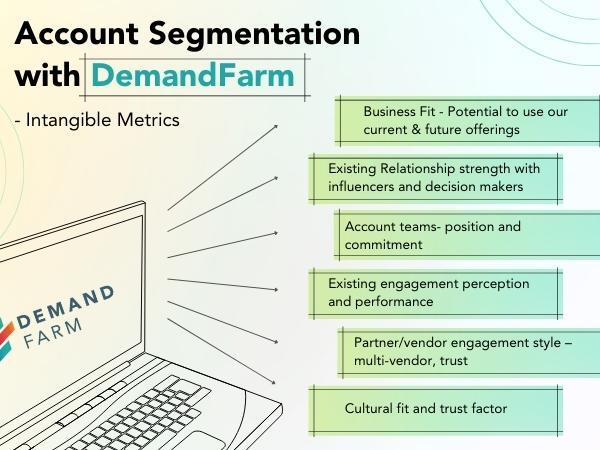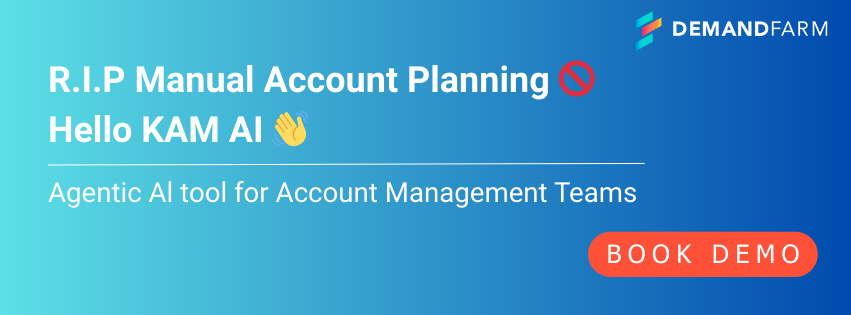Customer Segmentation for Key Accounts
Engaging with customers and striving for positive outcomes in those interactions play a vital role in helping a business succeed. From enterprises to SMBs in the B2B sphere, almost every organization is focusing on keeping up with the needs of their customers. With the widespread permeation of digital media, personalized communications and solutions have become commonplace. These granular, bespoke communications can be effective if they are delivered to the audience they’re intended to. Customer segmentation helps in identifying the shared characteristics so that these group of customers can receive our solutions & attention more effectively.
In SaaS companies, customer segmentation for key accounts is usually done based on the Annual Recurring Revenue (ARR) value of the customer organizations. Since ARR segments clients based on the revenue contributed, segmenting becomes easier – but it can be counterproductive when vendors prioritize accounts with high ARRs. The risk-avoidant nature of ARRs means customer success & account management teams have to segment their customers strategically and understand the similarities and differences between the needs of their clients.
Learn More: The Role of Key Account Management in Customer Success Management
The need for key account segmentation
Every customer is different – While some might expect customer success teams to help them understand the issue in detail, others might want minimal communication outside the scheduled interactions. Teams can put these two customers in separate segments, and create an accurate assessment of their needs. This helps teams get a clear understanding of the issues in front of their customers and deploy resources in an effective way. Unlike the old methods where large clients were clubbed together, developments in the area have resulted in methodologies that include companies from various industries, of different sizes and revenue, together. These methods ensure all customers across different segments get the same importance, but with different approaches that are suited to their needs.
Read More: What is Customer Centricity and Why it isn’t the destination?
Types of Key Account Segmentation
There is no dearth of customer success segmentation models, and teams can choose the one that suits their needs most. While traditional methods have lost their allure, certain new frameworks have shown value in customer segmentation. Based on the model that is chosen, teams have to consider the variables specific to the industry or business. The nature of the products and services being proposed also play a part in deciding the segmentation model to be used.
-
Trait-Based Segmentation
It relies on demographic information, like the industry, company size, latest developments in the sphere etc. This segmentation technique is easily identifiable, but the underlying assumption that shared traits between industries or companies also share desired outcomes can lead to misleading assumptions.
-
RFM-Based Segmentation
It stands for recency, frequency, and monetary aspects of the customer organization. Recency refers to the time elapsed since the last customer interaction, Frequency is about the number of times customers contact the vendor in a specified period of time, and Monetary aspects refer to the total spending of the customer with the vendor. These details help customer success teams to gauge the responsiveness of the customer and plan their proposal accordingly.
-
Value-Based Segmentation
Value-Based Segmentation groups customers according to the economic value they provide to the vendor. It focuses on the ARR potential of customer organizations, and groups them by subscription levels, production rates, existing ARRs, and similar metrics. Customer success & Key Account Management teams can locate upsell and cross-sell opportunities with this method, and serve existing customers better. It focuses attention on building relationships with customers, and improves the revenue potential over time.
-
Needs-Based Segmentation
It classifies customers based on specific needs. Customer success teams group customers who use products for similar objectives, and achieve targeted service delivery for every one of them.
Types of key account segmentation based on revenue
The process of segmentation differs from one methodology to another, but the steps involved largely remain the same. Segmentation on the basis of Revenue (MRR or ARR), one of the most prevalent methods, is usually done under the following labels:
-
Revenue Segmentation
Revenue Segmentation pays extra attention to customers who contribute more to the bottom line, because high-value customers usually have complex needs. The customer success teams should carefully select meaningful segment boundaries, where customers below and above revenue boundaries have varied needs – otherwise the difference in treatment can be jarring to the customers. Also, the matter of customers who downgrade their subscription or opt for a lower tier contract needs to be handled carefully, as dropping low in the order of importance can cause resentment when not handled diplomatically.
-
Revenue Potential
Revenue Potential of a customer might increase multiple times over the future, even if it is relatively low today. Or in case of enterprise clients, the partnership may start with a really small project, but if the team understands the potential of serving other departments/functions and tailor their product accordingly, there could be excellent upsell opportunities. By providing high value of service even at low MRR, the chances of getting bigger projects is increased.
-
Reference Accounts
Reference Accounts are customers who may not have a large relationship value, but have great contacts in the business to whom they can refer vendors to. If they are really happy with the limited partnership scope, then too they can serve as reference points for other prospects that customer success teams approach on their own.
-
Lifecycle Stage
Lifecycle Stage of customer technology adoption is very important for SaaS sales teams. Customers in the initial stages appreciate vendors taking the time to help them understand the intricacies of the field, and they need more upfront time investment than those who are in advanced stages of technology adoption.
-
Industry
Industry level segmentation makes sense if the vendor product is used by multiple industries in different ways (check out systems, for example – which can be used by PoS systems as well as warehouses). Teams can then focus on industry-specific messages while approaching customers.
-
At-risk Accounts
These are critical accounts where vendor organizations focus their energies on. By helping customers overcome their issues, customer success teams can expect the relationship to build over the years, but they must also be aware of the sunk-cost fallacy. A practical way would be to dedicate specific resources to at-risk accounts for a specified period of time, and evaluate how to continue at the end of the period.
Segmentation strategies should take the unique requirements of customers into account – be it product-based, geography-based, expertise-based, or return-based. Reducing the complications in these processes is important, as segmentation is necessary for a lot of ales activities to commence. The aim of the segmentation exercise should be to give customer success teams a clear understanding of the market in which they’re operating. This knowledge helps them to position the product better, and help customers relate to the solution. What customers want and expect should be one of the primary considerations while selecting a segmentation model. When the Customer success teams understand the importance of their product or service to customers, others with similar issues can be grouped together and a coherent solution can be reached, to avoid the obstacles. Choosing and implementing customer segmentation for customer success shows that vendor organization is striving to improve their offering, and elicits trust in customers. Having a complicated segmentation model, however, can increase churn and loss of promising accounts.
Segmentation strategies for key account management
Key Account Segmentation throws up details like which accounts need attention, which ones add significantly to the bottom line, which ones can be upsold, and many more. A traditional segmentation system will have customers separated by size – large, medium, and small – based on their contribution to the revenue. But a low-segment customer may have the potential to become the next unicorn, and the chances of vendors growing with them are very high. Such complex equations get lost in the noise. Here’s a look at a few segmentation options that can be used by key account management teams to complement their modern account management strategies. There is no right or wrong segmentation strategy here, just the ones that suit the kind of customers a vendor has.
Choosing the tools to plan segmentation
There are plenty of tools in the market that help in identifying the right-fit Key Accounts, and some have more compelling features that might suit a specific SaaS vendor. Ideally, a good tool should categorize accounts based on long-term growth potential, multi-level relationship health, strategic alignment of organizational goals & customer goals. It should provide a structured approach to periodically segmenting and prioritizing accounts, so that time and resources are invested in the most judicious way, while aligning product mix and service lines to produce stronger results.
DemandFarm’s Account Segmentation module is a qualitative and subjective assessment focused on evaluating the strategic relationship with your key accounts, taking inputs from the Account Manager.

Categorize Key Accounts based on a mix of qualitative and quantitative data that reveals the Account’s true potential and attractiveness.
Some of these are:
- Size of the company – $revenue, #employees
- Rate of growth in the last 3 years
- Relative growth as compared to competitors
- Leadership vision – long-term and progressive
- Accounts’ Brand value
This helps you assess the true potential of your existing accounts, and know where you should really focus your effort!
Bottom Line
Nearly 33% of a SaaS vendor’s revenue is usually a result of a few key accounts. Nurturing them and growing with those relationships is important to produce stronger results while lowering selling costs. Segmenting key accounts, therefore, becomes not only a matter of survival but future growth, too. Using relevant tools to ensure that correct data is used, can further client relationships and drive growth in the long term. Expanding market position or providing effective resource allocation becomes easier when teams have concrete data on customer issues, goals, and concerns. SaaS vendors can increase loyalty, sales, and revenue from their customers by forming deeper, more targeted relationships with them. Key Account management that is based on a clear segmentation helps customers enjoy an enhanced experience, while adding value to both parties. By providing exceptional service, SaaS vendors can build upon a solid foundation that is held together by actionable data. Using specialized tools to convert this institutional knowledge about the customers into an enterprise memory that every member of the vendor team can utilize, gives impetus to key accounts. When vendors organize their customers into manageable groups instead of handling every one of them as a unique case, they reduce a lot of time spent in understanding issues. This time can now be used to find a viable solution, be it in the form of a feature update or a new product. Clear segmentation helps vendors play the trusted advisor role to a majority of their customers, instead of merely providing a useful service.


